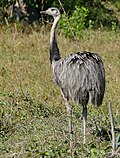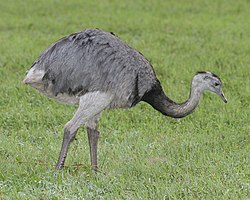Greater rhea
The greater rhea, Rhea americana, is a flightless bird found in South America. The greater rhea is also known as grey, common rhea, or the American rhea. The species, first described by Carl Linnaeus in 1758, is found in Argentina, Bolivia, Brazil, Paraguay, and Uruguay.
| Greater rhea | |
|---|---|

| |
| Conservation status | |
| Scientific classification | |
| Kingdom: | |
| Class: | |
| Subclass: | |
| Infraclass: | |
| Order: | |
| Family: | |
| Genus: | |
| Binomial name | |
| Rhea americana | |
The greater rhea takes its scientific name from the Greek goddess Rhea and the Latin word for "America".
It has a length of 3–5 feet (0.91–1.52 m) and a wingspan of 5 feet (1.5 m). Weighing 50–55 pounds (23–25 kg), the greater rhea is the largest bird in South America.[3]
Greater Rhea Media
Greater rhea, closeup, Cricket St Thomas Wildlife Park (Somerset, England)
Birds of the species, drinking water in the World of Birds, Cape Town, RSA
Wild greater rhea (probably R. a. albescens) in habitat, Goya Department, Corrientes Province, Argentina
Feral greater rhea in cereal field in Mecklenburg-Vorpommern, Germany. The species normally uses such monocultures to hide rather than to feed on the plants.
Egg, Collection Museum Wiesbaden, Germany
Two-month-old greater rhea in Tierpark Hagenbeck with hatchling at its feet
References
- ↑ "Rhea americana". IUCN Red List of Threatened Species. Version 2011.1. International Union for Conservation of Nature. 2008. Retrieved July 25, 2011.
- ↑ Blake, Emmet Reid (1977). Manual of Neotropical Birds: Spheniscidae (penguins) to Laridae (gulls and allies). University of Chicago Press. pp. 8–9. ISBN 0226056414.
- ↑ "Greater Rhea". National Geographic. 11 April 2010. Retrieved July 26, 2011.










